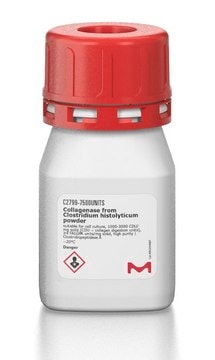C1889
Collagenasi
0.2 μm filtered, suitable for release of physiologically active rat hepatocytes, Type IV-S, 0.5-5.0 FALGPA units/mg solid, ≥125 CDU/mg solid
Sinonimo/i:
Clostridiopeptidasi A
About This Item
Prodotti consigliati
Livello qualitativo
Sterilità
0.2 μm filtered
Tipo
Type IV-S
Forma fisica
powder
Attività specifica
≥125 CDU/mg solid
0.5-5.0 FALGPA units/mg solid
PM
68-130 kDa
Compatibilità
suitable for release of physiologically active rat hepatocytes
applicazioni
diagnostic assay manufacturing
Temperatura di conservazione
−20°C
Cerchi prodotti simili? Visita Guida al confronto tra prodotti
Categorie correlate
Descrizione generale
Applicazioni
Azioni biochim/fisiol
Avvertenza
Definizione di unità
Nota sulla preparazione
Enzima
Inibitore
Substrato
Avvertenze
Danger
Indicazioni di pericolo
Consigli di prudenza
Classi di pericolo
Eye Irrit. 2 - Resp. Sens. 1 - Skin Irrit. 2 - STOT SE 3
Organi bersaglio
Respiratory system
Codice della classe di stoccaggio
11 - Combustible Solids
Classe di pericolosità dell'acqua (WGK)
WGK 1
Punto d’infiammabilità (°F)
Not applicable
Punto d’infiammabilità (°C)
Not applicable
Dispositivi di protezione individuale
dust mask type N95 (US), Eyeshields, Faceshields, Gloves
Certificati d'analisi (COA)
Cerca il Certificati d'analisi (COA) digitando il numero di lotto/batch corrispondente. I numeri di lotto o di batch sono stampati sull'etichetta dei prodotti dopo la parola ‘Lotto’ o ‘Batch’.
Possiedi già questo prodotto?
I documenti relativi ai prodotti acquistati recentemente sono disponibili nell’Archivio dei documenti.
I clienti hanno visto anche
Protocolli
To measure collagenase activity, N-(3-[2-Furyl]acryloyl)-Leu-Gly-Pro-Ala is used in a continuous spectrophotometric rate determination at 345 nm. Collagenase hydrolyzes collagen peptide bonds.
Il team dei nostri ricercatori vanta grande esperienza in tutte le aree della ricerca quali Life Science, scienza dei materiali, sintesi chimica, cromatografia, discipline analitiche, ecc..
Contatta l'Assistenza Tecnica.









